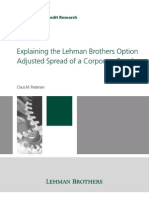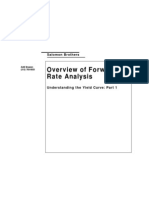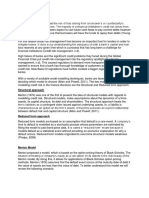0 ratings0% found this document useful (0 votes)
40 viewsLecture 5 Script
The professor discusses the Merton model for valuing risky debt. The model assumes the firm's asset value follows a log-normal distribution rather than stock price. It provides a formula for the asset value distribution based on drift, volatility, and standard normal distributions. Debt holders are paid if assets exceed face value at maturity, otherwise they own the firm. Equity is valued as a call option on assets using Black-Scholes. The model relates equity and asset volatilities through a leverage effect, showing equity volatility increases with leverage and asset risk. The model can then value debt as the difference between asset and equity values.
Uploaded by
Ashish MalhotraCopyright
© © All Rights Reserved
Available Formats
Download as TXT, PDF, TXT or read online on Scribd
0 ratings0% found this document useful (0 votes)
40 viewsLecture 5 Script
The professor discusses the Merton model for valuing risky debt. The model assumes the firm's asset value follows a log-normal distribution rather than stock price. It provides a formula for the asset value distribution based on drift, volatility, and standard normal distributions. Debt holders are paid if assets exceed face value at maturity, otherwise they own the firm. Equity is valued as a call option on assets using Black-Scholes. The model relates equity and asset volatilities through a leverage effect, showing equity volatility increases with leverage and asset risk. The model can then value debt as the difference between asset and equity values.
Uploaded by
Ashish MalhotraCopyright
© © All Rights Reserved
Available Formats
Download as TXT, PDF, TXT or read online on Scribd
You are on page 1/ 3
PROFESSOR: The Merton model provides
an analytical approximation formula for valuing risky debt.
It's in the spirit of the Black-Scholes-Merton model
but it's different in a number of respects.
Most fundamentally, it starts with the assumption
that it's the underlying firm asset
value that's log-normally distributed,
not its stock price.
The formula here represents the resulting distribution
of a firm's asset value, V sub T, at time T.
The value depends on a drift term that's
parameterized by a constant return parameter, mu,
and a volatility correction of minus one half sigma squared.
The volatility term is based on the parameter, sigma,
multiplied by the square root of the horizon, T, and by a draw
from a standard normal density function, epsilon.
Assets are financed with a combination of debt and equity.
The zero coupon debt is issued at time zero,
and comes due at time T. As we saw in the payoff diagrams,
the debt will be paid in full if the asset value V of T
covers its face value and the equity holders own
the remaining asset value.
If V sub T is less than F, the debt holders
become the owners of the firm, and the original equity holders
get nothing.
Although we're ultimately interested in valuing
the risky debt of the firm, the first step
is to value of the firm's equity, whose payoff is
the max of V of T minus F and zero,
which is a call option on the firm's assets.
Under the assumptions made, then, equity
can be valued using the Black-Scholes-Merton model
with the face value of debt as the strike price
and with the firm's assets as the underlying variable.
The familiar formula for the value of a call option
is shown here.
We know that the volatility of a firm's equity
can be estimated based on historical stock price data
or from implied volatilities of options
that are traded on the firm.
However, it's not easy to directly infer
the volatility of a firm's assets
because assets generally aren't traded.
Or to put it differently, we could estimate asset volatility
if we had historical data on both the market
value of a firm's equity and the market value of its debt,
but it's often difficult to find data
on the market price of a firm's debt
because either it trades infrequently
or it's privately placed and that information
isn't made public.
Professor Merton came up with a clever way
to get around that problem, which
is to use the formula for vega, the sensitivity of option
prices to changes in the volatility of the underlying
asset.
The formula for vega that comes out of the Black-Scholes-Merton
model implies that the volatility of equity returns --
here, sigma E --
is related to the volatility of asset returns, sigma,
by this equation.
Written in this form, vega highlights
that the volatility of equity can
be much larger than that of the assets
through a leverage effect, which concentrates the asset
volatility on the equity.
This equation can be simplified also
by noticing that the denominator is
the Black-Scholes-Merton value of a call option on assets,
which we determined is the value of the equity.
Notice that the leverage effect on volatility
gets larger as the firm becomes more distressed
and the value of equity falls.
A very important implication of this
is that, for firms that are close to insolvency,
analyzing the expected return on equity
using a linear model like a CAPM becomes
very problematic because when volatility changes, so will
the stock's beta.
These graphs demonstrate the effect of leverage
on the volatility of equity in the Merton model.
The top graph shows the relation as a function
of the value of assets, and the lower graph
shows that as a function of the value of equity.
In the bottom graph, the volatility
changes very dramatically when equity values are low,
underscoring the potential for significant time
variation in volatility in a distressed firm.
On both graphs, the volatility of assets
is plotted as a flat dashed line.
That's because, under the assumptions of the model,
asset volatility is constant over time,
and therefore independent of the value of assets or of equity.
We now have what we need to infer the market
value of assets and the volatility of assets,
assuming we can observe or estimate
the market value of equity and its volatility.
That is to say we have two nonlinear equations and two
unknowns, which are the initial market value of assets
and the volatility of assets.
The first equation is the formula
for equity as a call option, and the second equation
relates to volatility of equity to the volatility of assets.
These equations can be solved simultaneously
using numerical methods, for instance using Solver in Excel.
Now we have all the information needed
to achieve our main goal, which is to estimate the market
value of a firm's risky debt.
The value of the risky debt is the difference
between the value of assets, which we just imputed,
and the value of equity, which was established
to be the value of a call option on the firm's assets
with a strike price equal to the face value of the debt.
Using put-call parity, the value of the debt
can also be described as the difference between the value
of the debt if it were risk-free and the value of a put option
on the assets with a strike price of F and an expiration
date the same as the maturity date on the debt.
That's exactly what we saw before on the payoff diagram,
that risky debt is equivalent to a long position in safe debt
and a short position in a put option.
Remember, too, that the value of the put option
equals the value of a full guarantee on the debt.
You might also like
- Explaining The Lehman Brothers Option Adjusted Spread of A Corporate Bond - Claus PedersenNo ratings yetExplaining The Lehman Brothers Option Adjusted Spread of A Corporate Bond - Claus Pedersen20 pages
- Trading Implied Volatility: Extrinsiq Advanced Options Trading Guides, #4From EverandTrading Implied Volatility: Extrinsiq Advanced Options Trading Guides, #44/5 (1)
- Risk in Capital Structure Arbitrage 2006No ratings yetRisk in Capital Structure Arbitrage 200646 pages
- Chapter 15: Capital Structure Decisions: Page 1100% (1)Chapter 15: Capital Structure Decisions: Page 164 pages
- Scheinkman Common Factors Affecting Bond ReturnsNo ratings yetScheinkman Common Factors Affecting Bond Returns8 pages
- Week 7: Corporate Credit Risk Models Based On Stock PriceNo ratings yetWeek 7: Corporate Credit Risk Models Based On Stock Price19 pages
- The Structural Approach To Default Prediction and ValuationNo ratings yetThe Structural Approach To Default Prediction and Valuation35 pages
- Delta Hedging A Two Fixed Income Securities Portfolio Under Gamma and Vega Constraints The Example of Mortgage Servicing RightsNo ratings yetDelta Hedging A Two Fixed Income Securities Portfolio Under Gamma and Vega Constraints The Example of Mortgage Servicing Rights4 pages
- Comparing Models of Corporate Bankruptcy Prediction PDFNo ratings yetComparing Models of Corporate Bankruptcy Prediction PDF21 pages
- 2011 06 07 MS&E444 CapStrucArb Implied Index TradingNo ratings yet2011 06 07 MS&E444 CapStrucArb Implied Index Trading17 pages
- A Structural Credit-Risk Model Based On A Jump DiffusionNo ratings yetA Structural Credit-Risk Model Based On A Jump Diffusion28 pages
- SSB 1995 - Part 1 Overview of Forward Rate Analysis - Understanding The Yield Curve Part 1No ratings yetSSB 1995 - Part 1 Overview of Forward Rate Analysis - Understanding The Yield Curve Part 124 pages
- (Citibank) Using Asset Swap Spreads To Identify Goverment Bond Relative-Value0% (2)(Citibank) Using Asset Swap Spreads To Identify Goverment Bond Relative-Value12 pages
- Development of Algorithmic Volatility Trading Strategies For Equity OptionsNo ratings yetDevelopment of Algorithmic Volatility Trading Strategies For Equity Options18 pages
- Shrinking The Term Structure - GP ApproachNo ratings yetShrinking The Term Structure - GP Approach70 pages
- Pricing Default Swaps: Empirical EvidenceNo ratings yetPricing Default Swaps: Empirical Evidence49 pages
- Estimating Structural Models of Corporate Bond Prices in Indonesian CorporationsNo ratings yetEstimating Structural Models of Corporate Bond Prices in Indonesian Corporations12 pages
- Table of Contents................................................................................... 1 I.A New Approach To Real Estate Risk by Dibartolomeo, Et - Al.................... 2No ratings yetTable of Contents................................................................................... 1 I.A New Approach To Real Estate Risk by Dibartolomeo, Et - Al.................... 233 pages
- Vasicek - Term Structure Modeling Using Exponential SplinesNo ratings yetVasicek - Term Structure Modeling Using Exponential Splines11 pages
- Predicting Financial Distress and The Performance of Distressed StocksNo ratings yetPredicting Financial Distress and The Performance of Distressed Stocks34 pages
- Capital Asset Pricing Model: Make smart investment decisions to build a strong portfolioFrom EverandCapital Asset Pricing Model: Make smart investment decisions to build a strong portfolio4.5/5 (3)
- Quantum Strategy: Winning Strategies of Professional InvestmentFrom EverandQuantum Strategy: Winning Strategies of Professional InvestmentNo ratings yet
- Second Phase: Toyota Analysis Project IFE MatrixNo ratings yetSecond Phase: Toyota Analysis Project IFE Matrix7 pages
- Century Plyboards (India) Limited: Summary of Rated Instruments Instrument Rated Amount (In Crore) Rating ActionNo ratings yetCentury Plyboards (India) Limited: Summary of Rated Instruments Instrument Rated Amount (In Crore) Rating Action8 pages
- Aeseiah Final Recitation Simple and Compound InterestNo ratings yetAeseiah Final Recitation Simple and Compound Interest3 pages
- Negotiable Instruments Law: CASES: Phil. Educ. Co., Inc. vs. Soriano, 39 SCRA 587 TibajiaNo ratings yetNegotiable Instruments Law: CASES: Phil. Educ. Co., Inc. vs. Soriano, 39 SCRA 587 Tibajia8 pages
- Full download Design is the Problem The Future of Design Must Be Sustainable 1st Edition Nathan Shedroff ebook PDF & DOCX all chaptersNo ratings yetFull download Design is the Problem The Future of Design Must Be Sustainable 1st Edition Nathan Shedroff ebook PDF & DOCX all chapters83 pages
- Century Textiles & Industries Limited 1433 QuarterUpdateNo ratings yetCentury Textiles & Industries Limited 1433 QuarterUpdate3 pages
- Test Bank For Financial Institutions Markets and Money 11th Edition Kidwell100% (46)Test Bank For Financial Institutions Markets and Money 11th Edition Kidwell5 pages
- Financial Performance Evaluation of Dutch Bangla Bank LimitedNo ratings yetFinancial Performance Evaluation of Dutch Bangla Bank Limited10 pages
- Chapter Vi: Rights of Stockholders and MembersNo ratings yetChapter Vi: Rights of Stockholders and Members7 pages





































































































